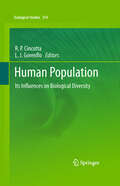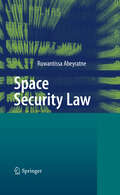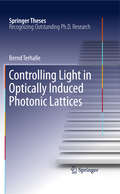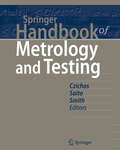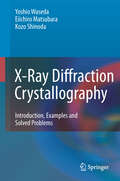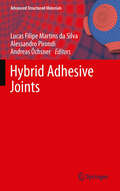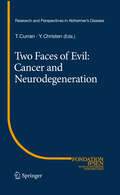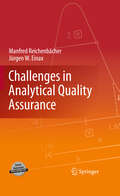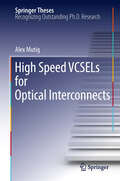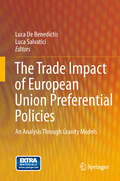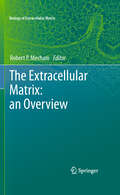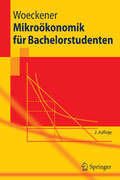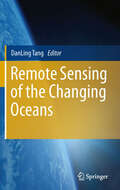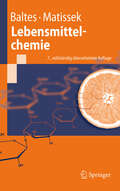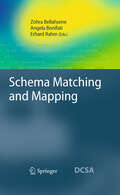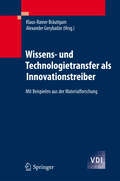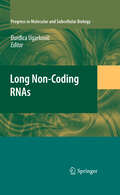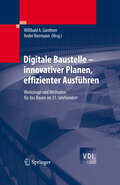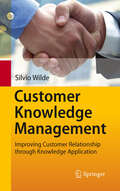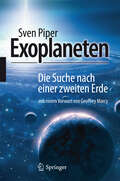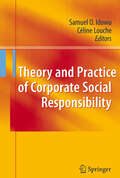- Table View
- List View
Encyclopedia of Biophysics
by Gordon Roberts European Biophysical Societies' AssociationThe Encyclopedia of Biophysics is envisioned both as an easily accessible source of information and as an introductory guide to the scientific literature. It includes entries describing both Techniques and Systems. In the Techniques entries, each of the wide range of methods which fall under the heading of Biophysics are explained in detail, together with the value and the limitations of the information each provides. Techniques covered range from diffraction (X-ray, electron and neutron) through a wide range of spectroscopic methods (X-ray, optical, EPR, NMR) to imaging (from electron microscopy to live cell imaging and MRI), as well as computational and simulation approaches. In the Systems entries, biophysical approaches to specific biological systems or problems - from protein and nucleic acid structure to membranes, ion channels and receptors - are described. These sections, which place emphasis on the integration of the different techniques, therefore provide an inroad into Biophysics from a biological more than from a technique-oriented physical/chemical perspective. Thus the Encyclopedia is intended to provide a resource both for biophysicists interested in methods beyond those used in their immediate sub-discipline and for those readers who are approaching biophysics from either a physical or biological background.
Human Population
by Richard P. Cincotta Larry J. GorenfloIn this volume the dynamic patterns of human density and distribution are examined in relation to the viability of native species and the integrity of their habitats. Social, biological, and earth scientists describe their models, outline their conclusions from field studies, and review the contributions of other scientists whose work is essential to this field. The book starts with general theories and broad empirical relationships that help explain dramatic changes in the patterns of the occurrence of species, changes that have developed in parallel with human population growth, migration and settlement. In the following chapters specific biomes and ecosystems are highlighted as the context for human interactions with other species. A discussion of the key themes and findings covered rounds out the volume. All in all, the work presents our species, Homo sapiens, as what we truly have been and will likely remain--an influential, and often the most influential, constituent in nearly every major ecosystem on Earth.
Space Security Law
by Ruwantissa AbeyratneAgainst the variegated background of bewilderment and cautious optimism that space transportation offers, this book begins with an exposé on international politics, the principles of which, bear upon space transportation, as well as the closeness of air space and outer space, and activities that straddle both frontiers at the same time. It discusses current issues and possibilities of communications and transportation in outer space, as well as the liabilities and accountability of the key players of space exploration.
Controlling Light in Optically Induced Photonic Lattices (Springer Theses)
by Bernd TerhalleDiscrete periodic structures play an important role in physics, and have opened up an exciting new area of investigation in recent years. Questions relating to the control of light in such structures still represent a major challenge. It is this highly active field that is addressed in the present thesis. Using the model system of a photorefractive nonlinearity that allows one to simultaneously create and control photonic lattices by light, the author obtains a comprehensive picture of the control of nonlinear and quantum optics phenomena in photonic lattices. He describes and demonstrates experimentally for the first time resonant transitions in two-dimensional hexagonal lattices, including Rabi oscillations and Landau-Zener tunneling, as well as the direct control and exploitation of these transitions. A particular highlight of this thesis is the study of soliton-cluster switching and control of Zener tunneling.
Springer Handbook of Metrology and Testing
by Tetsuya Saito Leslie E. Smith Horst CzichosThis Springer Handbook of Metrology and Testing presents the principles of Metrology - the science of measurement - and the methods and techniques of Testing - determining the characteristics of a given product - as they apply to chemical and microstructural analysis, and to the measurement and testing of materials properties and performance, including modelling and simulation. The principal motivation for this Handbook stems from the increasing demands of technology for measurement results that can be used globally. Measurements within a local laboratory or manufacturing facility must be able to be reproduced accurately anywhere in the world. The book integrates knowledge from basic sciences and engineering disciplines, compiled by experts from internationally known metrology and testing institutions, and academe, as well as from industry, and conformity-assessment and accreditation bodies. The Commission of the European Union has expressed this as there is no science without measurements, no quality without testing, and no global markets without standards.
X-Ray Diffraction Crystallography
by Eiichiro Matsubara Kozo Shinoda Yoshio WasedaX-ray diffraction crystallography for powder samples is a well-established and widely used method. It is applied to materials characterization to reveal the atomic scale structure of various substances in a variety of states. The book deals with fundamental properties of X-rays, geometry analysis of crystals, X-ray scattering and diffraction in polycrystalline samples and its application to the determination of the crystal structure. The reciprocal lattice and integrated diffraction intensity from crystals and symmetry analysis of crystals are explained. To learn the method of X-ray diffraction crystallography well and to be able to cope with the given subject, a certain number of exercises is presented in the book to calculate specific values for typical examples. This is particularly important for beginners in X-ray diffraction crystallography. One aim of this book is to offer guidance to solving the problems of 90 typical substances. For further convenience, 100 supplementary exercises are also provided with solutions. Some essential points with basic equations are summarized in each chapter, together with some relevant physical constants and the atomic scattering factors of the elements.
Hybrid Adhesive Joints
by Andreas Öchsner Lucas F. Silva Alessandro PirondiThis volume presents treat the material science and mechanical issues of hybrid adhesive bonds which are a combination of adhesive bonding rather than mechanical fasteners. The idea of hybrid joints is to gather the advantages of the different techniques leaving out their problems. Some of the advantages of these joints are a higher static and fatigue strength and a higher stiffness with respect to simple joints, a two-stage cracking process before the final failure and improved durability. The book treats all important kinds of joints which are in use today: weld - adhesive, rivet - adhesive, clinch - adhesive, bolt - adhesive, and adhesive - adhesive. A section dedicated to threadlocking and interference-fit adhesive joints is also included. All sections are treated from a scientific point of view with modeling issues supported by simple coupons testing and a technological point of view where the idea is to present more applied results with practical cases.
Two Faces of Evil: Cancer and Neurodegeneration
by Yves Christen Thomas CurranHomeostasis involves a delicate interplay between generative and degenerative processes to maintain a stable internal environment. In biological systems, equilibrium is established and controlled through a series of negative feedback mechanisms driven by a range of signal transduction processes. Failures in these complex communication pathways result in instability leading to disease. Cancer represents a state of imbalance caused by an excess of cell proliferation. In contrast, neurodegeneration is a consequence of excessive cell loss in the nervous system. Both of these disorders exhort profound tolls on humanity and they have been subject to a great deal of research designed to ameliorate this suffering. For the most part, the topics have been viewed as distinct and rarely do opportunities arise for transdisciplinary discussions among experts in both fields. However, cancer and neurodegeneration represent yin-yang counterpoints in the regulation of cell growth, and it is reasonable to hypothesize that key regulatory events mediated by oncogenes and tumor suppressor genes in cancer may also affect neurodegenerative processes
Challenges in Analytical Quality Assurance
by Manfred Reichenbächer Jürgen W. EinaxWorking in the lab, but unsure what your results actually mean? Would you like to know how to apply trueness tests, calculate standard deviations, estimate measurement uncertainties or test for linearity? This book offers you a problem-based approach to analytical quality assurance (AQA). After a short introduction into required fundamentals, various topics such as statistical tests, linear regression and calibration, tool qualification or method validation are presented in the form of exercises for self-study. Solutions are provided in a clear step-by-step manner. Interactive Excel-sheets are available as Extra Materials for trying out the various concepts. For professionals as well as graduate students confronted with analytical quality assurance for the first time, this book will be the clue to meeting such challenges.
High Speed VCSELs for Optical Interconnects
by Alex MutigThe transmission speed of data communication systems is forecast to increase exponentially over the next decade. Development of both Si-based high-speed drivers as well as III-V-semiconductor-based high-speed vertical cavity surface emitting lasers (VCSELs) are prerequisites for future ultrahigh data-rate systems. This thesis presents: - a survey of the present state of the art of VCSELs - a systematic investigation of the various effects limiting present VCSELs - a catalogue of solutions to overcome present limits - detailed progress in modelling, fabricating and testing the currently most advanced VCSELs at the two commercially most important wavelengths.
The Trade Impact of European Union Preferential Policies
by Luca De Benedictis Luca SalvaticiThe book investigates the EU preferential trade policy and, in particular, the impact it had on trade flows from developing countries. It shows that the capability of the "trade as aid" model to deliver its expected benefits to these countries crucially differs between preferential schemes and sectors. The book takes an eclectic but rigorous approach to the econometric analysis by combining different specifications of the gravity model. An in-depth presentation of the gravity model is also included, providing significant insights into the distinctive features of this technique and its state-of-art implementation. The evidence produced in the book is extensively applied to the analysis of the EU preferential policies with substantial suggestions for future improvement. Additional electronic material to replicate the book's analysis (datasets and Gams and Stata 9.0 routines) can be found in the Extra Materials menu on the website of the book.
The Extracellular Matrix: an Overview
by Robert MechamKnowledge of the extracellular matrix (ECM) is essential to understand cellular differentiation, tissue development, and tissue remodeling. This volume of the series "Biology of Extracellular Matrix" provides a timely overview of the structure, regulation, and function of the major macromolecules that make up the extracellular matrix. It covers topics such as collagen types and assembly of collagen-containing suprastructures, basement membrane, fibronectin and other cell-adhesive glycoproteins, proteoglycans, microfibrils, elastin, fibulins and matricellular proteins, such as thrombospondin. It also explores the concept that ECM components together with their cell surface receptors can be viewed as intricate nano-devices that allow cells to physically organize their 3-D-environment. Further, the role of the ECM in human disease and pathogenesis is discussed as well as the use of model organisms in elucidating ECM function.
Mikroökonomik für Bachelorstudenten
by Bernd WoeckenerDas Buch führt systematisch in die Grundlagen der Mikroökonomik ein. Behandelt werden Unternehmensentscheidungen und Entscheidungen privater Haushalte auf Güter- und Faktormärkten sowie die Marktgleichgewichte, die aus der Wechselwirkung zwischen beiden Seiten entstehen. Betrachtet wird zudem die Rolle des Staates bei der Internalisierung externer Effekte und bei der Einkommens(um)verteilung. Die Kombination von analytischer Herleitung im Text und bildlicher Herleitung durch Illustrationen macht das Buch besonders wertvoll für Bachelor-Studierende.
Remote Sensing of the Changing Oceans
by Danling TangRemote Sensing of the Changing Oceans is a comprehensive account of the basic concepts, theories, methods and applications used in ocean satellite remote sensing. The book provides a synthesis of various new ideas and theories and discusses a series of key research topics in oceanic manifestation of global changes as viewed from space. A variety of research methods used in the analysis and modeling of global changes are introduced in detail along with numerous examples from around the world's oceans. The authors review the changing oceans at different levels, including Global and Regional Observations, Natural Hazards, Coastal Environment and related scientific issues, all from the unique perspective of Satellite Observation Systems. Thus, the book not only introduces the basics of the changing oceans, but also new developments in satellite remote sensing technology and international cooperation in this emerging field. Danling Tang (Lingzis) received her Ph.D from Hong Kong University of Science and Technology. She conducted research and teaching in Hong Kong, USA, Japan, and South Korea for more than 10 years; in 2004, she received "100 Talents Program of Chinese Academy of Sciences" and returned to China. She was a professor of Fudan University, and now is a Leading Professor of "Remote Sensing of Marine Ecology and Environment" at the South China Sea Institute of Oceanology, Chinese Academy of Sciences. Dr. Tang has been working on satellite remote sensing of marine ecology and environment; her major research interests include ocean dynamics of phytoplankton bloom, global environmental changes, and natural hazards. Dr. Tang has organized several international conferences, workshops, and training, she also services as member of organizing committee for several international scientific organizations; she was the Chairman of the 9th Pan Ocean Remote Sensing Conference (PORSEC 2008), and currently is the President-elect of PORSEC Association.
Lebensmittelchemie
by Reinhard Matissek Werner BaltesDas Lehrbuch basiert auf einem systematischen Gesamtkonzept mit klarer Gliederung und einer Sammlung relevanter Fakten. In der vollständig überarbeiteten achten Auflage bietet es eine prägnante Übersicht über das gesamte Gebiet der modernen Lebensmittelchemie mit neuen, hoch aktuellen Themen aus den Bereichen Lebensmittelsicherheit Lebensmittelqualität Ernährungswissen Lebensmittelherstellung Dieses Buch richtet sich in erster Linie an Studierende der Lebensmittelchemie, der Lebensmitteltechnologie, der Ernährungswissenschaften und der Chemie. Aber auch Studierende anderer Life Sciences (wie Veterinärmedizin und Medizin) können von diesem Werk profitieren. Praktizierende in den Bereichen Lebensmittelsicherheit, Qualitätsmanagement, Forschung und Entwicklung vieler lebensmittelchemisch arbeitender Einrichtungen der Wirtschaft, Behörden und Hochschulen finden hiermit ein handliches Quick-Reading-Manual.
Schema Matching and Mapping
by Erhard Rahm Angela Bonifati Zohra BellahseneSchema Matching and Mapping provides an overview of the ways in which the schema and ontology matching and mapping tools have addressed information systems requirements. Topics include effective methods for matching data, mapping transformation verification, mapping-driven schema evolution and merging.
Wissens- und Technologietransfer als Innovationstreiber
by Alexander Gerybadze Klaus-Rainer BräutigamWissens- und Technologietransfer kann beides bewirken: Innovationen antreiben oder hemmen. Am Beispiel der Materialforschung analysieren die Autoren, welche Bedingungen erfüllt sein müssen, damit der Transfer von Wissen- und Technologie aus öffentlich geförderten Forschungseinrichtungen in die Industrie gelingt. Grundlage sind empirische Erhebungen, Recherchen und die Evaluation von Transfervorhaben. Die Empfehlungen richten sich an Forscher, Forschungseinrichtungen und Partner aus der Industrie, die an neuen Produkten und Technologien arbeiten.
Nanophenomena at Surfaces
by Michail MichailovThis book presents the state of the art in nanoscale surface physics. It outlines contemporary trends in the field covering a wide range of topical areas: atomic structure of surfaces and interfaces, molecular films and polymer adsorption, biologically inspired nanophysics, surface design and pattern formation, and computer modeling of interfacial phenomena. Bridging "classical" and "nano" concepts, the present volume brings attention to the physical background of exotic condensed-matter properties. The book is devoted to Iwan Stranski and Rostislaw Kaischew, remarkable scientists, who played a crucial role in setting up the theoretical fundamentals of nucleation and crystal growth phenomena in the last century.
Essenz der Führung
by Martina Aron-WeidlichWas genau sollte eine Führungskraft wissen, um professionell und zielorientiert führen zu können? Aus einer Vielzahl von Methoden, Werkzeugen und Handlungsanweisungen bietet dieses Buch eine Auswahl an kompakt aufbereitetem Führungswissen - stets mit Fokus auf Praxisnähe und Umsetzbarkeit. Beispiele aus der Führungspraxis zeigen verschiedene Führungskulturen in unterschiedlichen Branchen. Checklisten und Handlungsleitfäden helfen bei der effektiven Umsetzung komplexer Führungsaufgaben.
Long Non-Coding RNAs
by Durdica UgarkovicLong non-coding RNAs (lncRNAs), tentatively defined as ncRNAs of more than two hundred nucleotides in length, are characterized by the complexity and diversity of their sequences and mechanisms of action. Based on genome-wide studies, more than 3,300 of them exist, but to date only the limited number of functional lncRNAs have been identified and characterized. Nonetheless, lncRNAs have emerged as key molecules involved in the control of transcriptional and posttranscriptional gene regulatory pathways. They take part in the recruitment of chromatin modifying complexes and regulate splicing, localization, stability and translation of the target mRNAs. This book provides an overview of the rapidly advancing field of long ncRNAs, describing the epigenetic and non-epigenetic mechanisms by which they regulate various biological functions in model systems, from yeast to mammals. The role of ncRNAs in sex chromosome dosage compensation in flies and mammals is described, as well as their role in centromere and telomere biology. Long non-coding RNAs involved in environmental stress response and development are presented and their mechanisms of action discussed.
Urinary Tract
by Karl-Erik Andersson Martin C. MichelThe basic anatomy and physiology of the urinary tract, the validity of animal models and other methodological considerations as well as a range of potential therapeutic targets are comprehensively reviewed by leading international experts, making this a unique reference source for basic scientists and research-minded clinicians alike
Digitale Baustelle- innovativer Planen, effizienter Ausführen
by Willibald Günthner André BorrmannDas Konzept der digitalen Baustelle beschreibt die Abbildung aller bei einem Bauvorhaben anfallenden Daten in einem Baustellenmodell. Es bietet die Grundlage für einen durchgängigen Datenfluss und damit für effizientere Planungs- und Ausführungsprozesse. In dem Band stellen Experten aus Wissenschaft und Industrie Methoden und Technologien zur Umsetzung vor, darunter die 3D-gestützte Planung, die Nutzung von Systemen zur zentralen Datenhaltung, die computergestützte Simulation des Bauablaufs und die Einführung moderner Logistikkonzepte.
Customer Knowledge Management: Improving Customer Relationship through Knowledge Application (Management for Professionals)
by Silvio WildeManaging and transferring knowledge - at the right time, in the right place and with the right quality for customers - enables companies to survive in times of fierce competition. The focus of this work is therefore on Knowledge Management and Customer Relationship Management. The theoretical part comprises several approaches to knowledge, its transfer and the barriers to be overcome when sharing knowledge. This is followed by a description of CRM and CKM (Customer Knowledge Management), outlining how crucial their successful use is. The practical part explores on the one hand the dependence on knowledge and on the other hand its availability for a good customer relationship. It includes a case study that investigates both the administrative and the operational area of a concrete company. The survey results are then discussed in detail, key success factors identified and mistakes pointed out. After this critical analysis, final recommendations are given that every company can benefit from.
Exoplaneten
by Sven PiperDie Erforschung des Weltalls und die Suche nach anderen Planeten entwickeln sich in den letzten Jahren rasant. Trotz begrenzter technischer Möglichkeiten wurden schon über 450 extrasolare Planeten entdeckt. Diese Einführung in die Forschung gibt detaillierte Einblicke in die Methodik, Missionen und Ergebnisse der Thematik sowie einen Ausblick auf zukünftige Fortschritte, wie die Entdeckung erdähnlicher Planeten binnen weniger als einem Jahrzehnt. Weltführende Experten kommentieren allgemeinverständlich und fundiert die Entwicklungen. Für die zweite Auflage hat der Autor einige Teile des Buches erweitert und überarbeitet sowie aktualisiert.
Theory and Practice of Corporate Social Responsibility
by Samuel O Idowu Celine LoucheModern businesses and organizations understand that corporate social responsibility (CSR) has become an important factor for sustainable success. At the same time CSR has established itself as a widely accepted element of courses in managerial training and education. This book, designed to support CSR teaching, collects 14 essays that clearly illustrate and explain the benefits and challenges of socially responsible corporate policies. Aligning theory and practice, the book focuses on four central themes: management, environment and sustainability, corporate social responsibility, and accounting and financial reporting. Business students and experienced managers alike will find this book a valuable resource that helps them to discover the strong forces that link successful management with corporate social responsibility.

